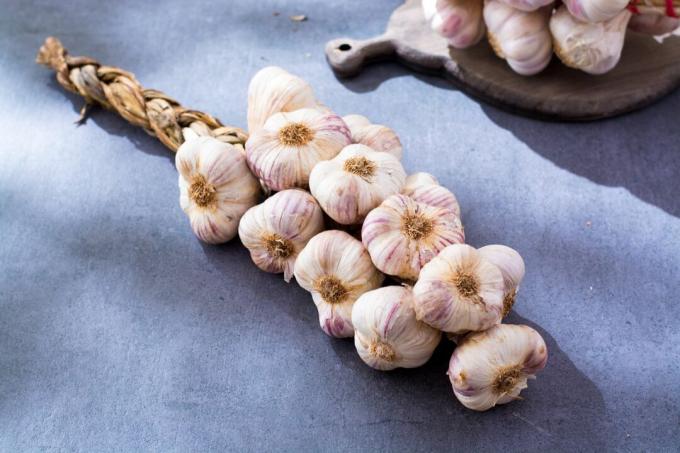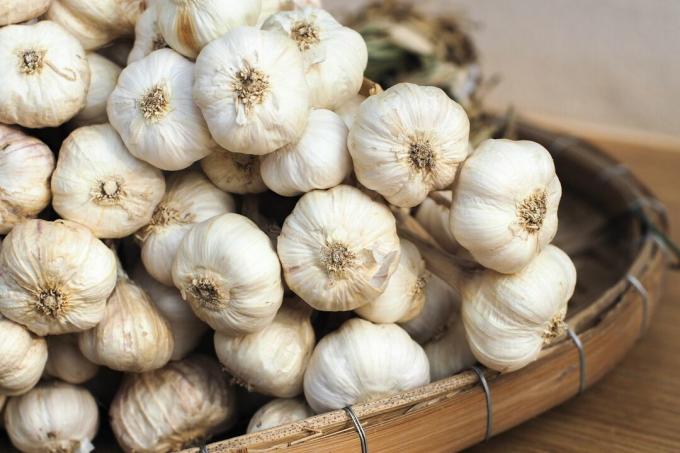Harvesting garlic and storing it properly is not always easy. These tips and tricks will help with drying, storing, and pickling garlic.

garlic (Allium sativum) can be found in almost every kitchen and it can be easily grown in your own garden. In order for the cultivation to promise success, correct harvesting and storage is important in order to preserve the popular "tuber". In the case of garlic in particular, the right procedure is therefore required so that the garlic cloves remain fresh and the aroma is retained. The following guide is designed to help you do everything right when harvesting and storing your garlic.
contents
- Harvest garlic
- Dry garlic
-
Storing garlic: soaking, freezing or at room temperature?
- Storage at room temperature
- Freezing garlic: opinions differ
- Pickle garlic
Harvest garlic
Planting the garlic is usually done in autumn and / or spring. Therefore, the harvest times are also different: When the garlic is planted in autumn, harvesting can start as early as July. It takes a few weeks longer to stick in spring, the harvest time is from late summer to autumn. In addition to the earlier harvest, planting the garlic cloves in autumn also offers another advantage: Due to the longer growing time, the yield is higher than with sticking in spring.

Fortunately, the plant shows when the right harvest time has been reached by its leaves: It can be harvested as soon as the upper third of the plant wilts. However, you should not wait too long, otherwise the "bulb" will split into individual cloves of garlic. This means that it can no longer be hung up to dry. To harvest the garlic, the whole plants are pulled out of the ground as carefully as possible. Damage to the garlic bulb will reduce its shelf life.
Dry garlic
Drying the garlic is very important as a first step in making the toes durable for a longer period of time. After harvesting, the freshly grown plants and onions are placed on the bed to dry for a few days - the prerequisite is of course dry weather. Then it is a good idea to hang up the garlic. It can be made very durable by braiding the green of several garlic plants into a braid and hanging it in a cool and dark place. When choosing the drying location, it is essential to ensure good ventilation, otherwise mold growth is possible. For drying the garlic braids, for example, if there is good ventilation, a garage or a roof can be used. You should not wash the garlic after the harvest due to mold!
After one to a maximum of two months, the garlic is usually sufficiently dried. This can be recognized by the wrinkled skin and the paper-like consistency of the foliage.

These tips should be kept in mind when drying garlic:
- Dry on the bed after the harvest
- Braid the greens together with the onion
- Hang in a well-ventilated, shady and cool place
- Do not wash garlic after harvesting!
Storing garlic: soaking, freezing or at room temperature?
After the garlic has been successfully dried, it is important to store the aromatic "bulbs" properly. After drying on the braid, you can easily cut a garlic bulb from the bundle. First the root hairs and several layers of the skin should be removed. There are a variety of methods that can be used to properly store garlic and extend its shelf life. The following methods are good for storage.
Storage at room temperature
Garlic can be stored very well for several weeks to months at room temperature. A basket or an airy bag is suitable for this. Direct sunlight should be avoided as it increases the premature expulsion of the garlic cloves. Good ventilation is also important during storage, so it should never be kept in a closed container. Otherwise there is a risk of mold growth. The same applies to storage in the refrigerator: Due to the moisture, the garlic cloves spoil quickly and should therefore under no circumstances be stored there. It also causes the garlic to lose its aroma.

The following instructions should be observed when storing at room temperature:
- Airy storage (e.g. B. Basket or open bag)
- No direct sunlight
- Not in a closed container or refrigerator!
Freezing garlic: opinions differ
Another method of preserving food is freezing. This type of storage is also possible with garlic. To do this, the garlic bulbs are either whole or the cloves are chopped, wrapped in plastic wrap and placed in the freezer. The disadvantage of this technique is that the garlic loses its taste, just like when it is stored in the refrigerator. That said, freezing is great for people who don't use a lot of garlic in cooking.
Pickle garlic
A popular way to preserve garlic is by soaking it in oil. In terms of taste, olive oil is best for this. To insert, the toes are first peeled and then poured into a clean glass together with the oil. The toes should be completely covered with oil. Alternatively, the toes can be heated in the oil for a few minutes at 90 ° C beforehand. The jar is then tightly closed and placed in the refrigerator or freezer.

But beware: Keeping it in a cool environment is very important as the bacterium Clostridium botulinum forms at room temperature. Bacteria of this kind lead to food poisoning, so the necessary cooling must be ensured!
Pickling garlic is child's play with these tips:
- Peel the garlic cloves
- Pour into glass together with olive oil and seal
- It is essential to store in the refrigerator or freezer, otherwise there is a risk of poisoning!
In case you haven't had enough of garlic, check out this article for some curious facts about garlic.
